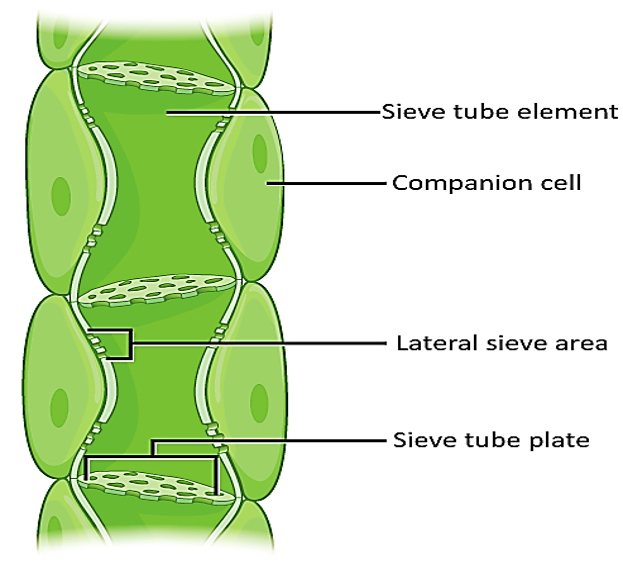
Callose can occur in
(a)Phloem parenchyma
(b)Companion cells
(c)Sieve tubes
(d)Tracheids
Answer
496.2k+ views
Hint: These are elongated living cells of the phloem in flowering plants. Its transverse end walls are pierced by sievelike groups of pores forming a plate-like structure that is mainly associated with the transport of food, mostly sugar.
Complete answer:
Callose is a plant polysaccharide that can occur in sieve tubes. It is not a constitutional component of the plant’s cell wall but is related to the plant’s defense mechanism. It is produced to act as a temporary cell wall in response to stress or damage. Callose gets collected in sieve plates to seal sieve plate pores of the sieve tube severing and even in response to minimal injury.
Additional Information: -Callose is composed of residues of glucose and is termed as β-glucan. It is prepared at the cell wall by the enzyme callose synthases and laid down at plasmodesmata, at the cell plate during cytokinesis, and pollen development.
-During wounding in the plant tissue, the callose is deposited at the plasmodesmata and cell wall for fixing the wound, this process is completed within minutes after damage.
-At the end of the growing season the deposits often appear at the sieve plates.
-Phloem parenchyma cells are located near the branches and terminations of sieve tubes in leaf veinlets.
-Companion cells are found within the phloem of a flowering plant closely associated with a sieve element.
-The tracheids are water-conducting cells of the xylem tissue.
So, the correct answer is, 'Sieve tubes'.
Note: -The temporary callose walls are also acting as a barrier between a cell and its environment, while the cell is undergoing genetic programming that allows it to change from one cell type to another cell type.
-Sieve tubes consist of elongated cells known as sieve elements that are connected via sieve plates to form a continuous tube system that spreads out through the entire plant body.
-Callose is produced in response to wounding, infection by pathogens, aluminum, and abscisic acid.

Complete answer:
Callose is a plant polysaccharide that can occur in sieve tubes. It is not a constitutional component of the plant’s cell wall but is related to the plant’s defense mechanism. It is produced to act as a temporary cell wall in response to stress or damage. Callose gets collected in sieve plates to seal sieve plate pores of the sieve tube severing and even in response to minimal injury.
Additional Information: -Callose is composed of residues of glucose and is termed as β-glucan. It is prepared at the cell wall by the enzyme callose synthases and laid down at plasmodesmata, at the cell plate during cytokinesis, and pollen development.
-During wounding in the plant tissue, the callose is deposited at the plasmodesmata and cell wall for fixing the wound, this process is completed within minutes after damage.
-At the end of the growing season the deposits often appear at the sieve plates.
-Phloem parenchyma cells are located near the branches and terminations of sieve tubes in leaf veinlets.
-Companion cells are found within the phloem of a flowering plant closely associated with a sieve element.
-The tracheids are water-conducting cells of the xylem tissue.
So, the correct answer is, 'Sieve tubes'.
Note: -The temporary callose walls are also acting as a barrier between a cell and its environment, while the cell is undergoing genetic programming that allows it to change from one cell type to another cell type.
-Sieve tubes consist of elongated cells known as sieve elements that are connected via sieve plates to form a continuous tube system that spreads out through the entire plant body.
-Callose is produced in response to wounding, infection by pathogens, aluminum, and abscisic acid.

Recently Updated Pages
Master Class 9 General Knowledge: Engaging Questions & Answers for Success

Master Class 9 English: Engaging Questions & Answers for Success

Master Class 9 Science: Engaging Questions & Answers for Success

Master Class 9 Social Science: Engaging Questions & Answers for Success

Master Class 9 Maths: Engaging Questions & Answers for Success

Class 9 Question and Answer - Your Ultimate Solutions Guide

Trending doubts
State and prove Bernoullis theorem class 11 physics CBSE

Who built the Grand Trunk Road AChandragupta Maurya class 11 social science CBSE

1 ton equals to A 100 kg B 1000 kg C 10 kg D 10000 class 11 physics CBSE

State the laws of reflection of light

One Metric ton is equal to kg A 10000 B 1000 C 100 class 11 physics CBSE

Difference Between Prokaryotic Cells and Eukaryotic Cells




